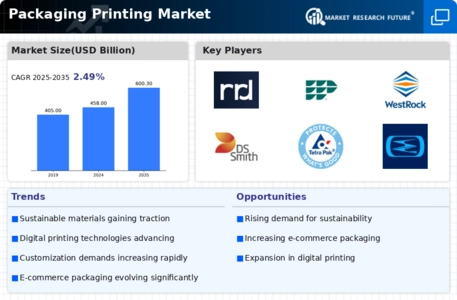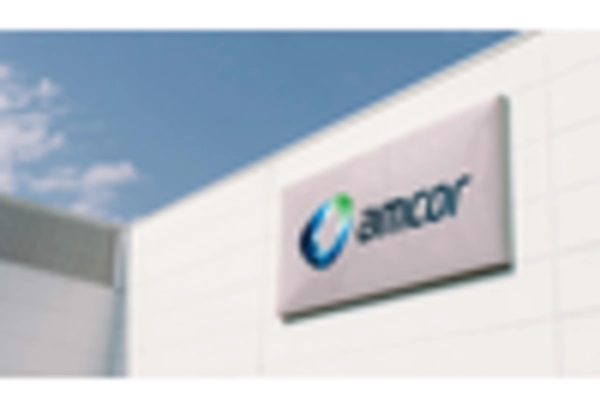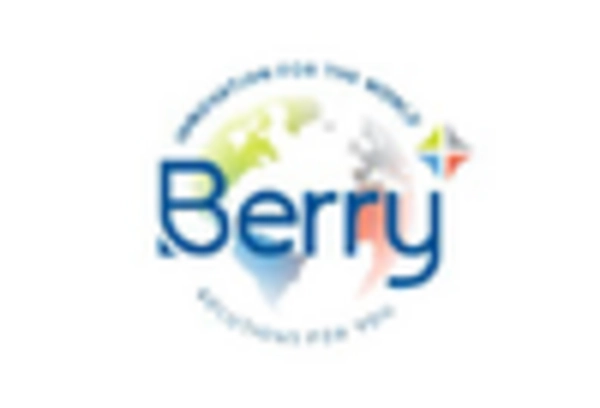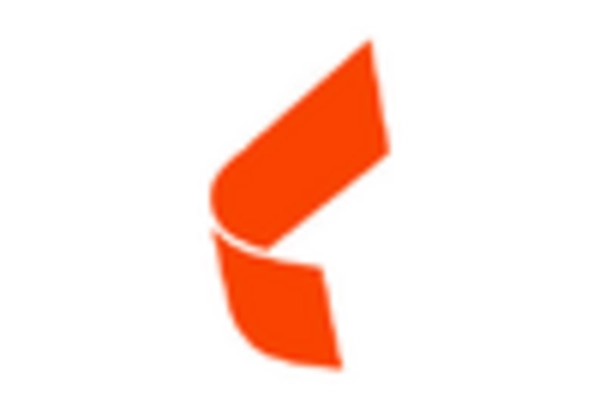Plastic
Paper
Metal
Glass
Flexographic Printing
Digital Printing
Rotogravure Printing
Offset Printing
Food and Beverage
Pharmaceuticals
Cosmetics
Consumer Goods
Labels
Flexible Packaging
Rigid Packaging
Corrugated Boxes
North America
Europe
South America
Asia Pacific
Middle East and Africa
North America Outlook (USD Billion, 2019-2035)
North America Packaging Printing Market by Material Type
Plastic
Paper
Metal
Glass
North America Packaging Printing Market by Printing Technology Type
Flexographic Printing
Digital Printing
Rotogravure Printing
Offset Printing
North America Packaging Printing Market by End Use Industry Type
Food and Beverage
Pharmaceuticals
Cosmetics
Consumer Goods
North America Packaging Printing Market by Packaging Type
Labels
Flexible Packaging
Rigid Packaging
Corrugated Boxes
North America Packaging Printing Market by Regional Type
US
Canada
US Outlook (USD Billion, 2019-2035)
US Packaging Printing Market by Material Type
Plastic
Paper
Metal
Glass
US Packaging Printing Market by Printing Technology Type
Flexographic Printing
Digital Printing
Rotogravure Printing
Offset Printing
US Packaging Printing Market by End Use Industry Type
Food and Beverage
Pharmaceuticals
Cosmetics
Consumer Goods
US Packaging Printing Market by Packaging Type
Labels
Flexible Packaging
Rigid Packaging
Corrugated Boxes
CANADA Outlook (USD Billion, 2019-2035)
CANADA Packaging Printing Market by Material Type
Plastic
Paper
Metal
Glass
CANADA Packaging Printing Market by Printing Technology Type
Flexographic Printing
Digital Printing
Rotogravure Printing
Offset Printing
CANADA Packaging Printing Market by End Use Industry Type
Food and Beverage
Pharmaceuticals
Cosmetics
Consumer Goods
CANADA Packaging Printing Market by Packaging Type
Labels
Flexible Packaging
Rigid Packaging
Corrugated Boxes
Europe Outlook (USD Billion, 2019-2035)
Europe Packaging Printing Market by Material Type
Plastic
Paper
Metal
Glass
Europe Packaging Printing Market by Printing Technology Type
Flexographic Printing
Digital Printing
Rotogravure Printing
Offset Printing
Europe Packaging Printing Market by End Use Industry Type
Food and Beverage
Pharmaceuticals
Cosmetics
Consumer Goods
Europe Packaging Printing Market by Packaging Type
Labels
Flexible Packaging
Rigid Packaging
Corrugated Boxes
Europe Packaging Printing Market by Regional Type
Germany
UK
France
Russia
Italy
Spain
Rest of Europe
GERMANY Outlook (USD Billion, 2019-2035)
GERMANY Packaging Printing Market by Material Type
Plastic
Paper
Metal
Glass
GERMANY Packaging Printing Market by Printing Technology Type
Flexographic Printing
Digital Printing
Rotogravure Printing
Offset Printing
GERMANY Packaging Printing Market by End Use Industry Type
Food and Beverage
Pharmaceuticals
Cosmetics
Consumer Goods
GERMANY Packaging Printing Market by Packaging Type
Labels
Flexible Packaging
Rigid Packaging
Corrugated Boxes
UK Outlook (USD Billion, 2019-2035)
UK Packaging Printing Market by Material Type
Plastic
Paper
Metal
Glass
UK Packaging Printing Market by Printing Technology Type
Flexographic Printing
Digital Printing
Rotogravure Printing
Offset Printing
UK Packaging Printing Market by End Use Industry Type
Food and Beverage
Pharmaceuticals
Cosmetics
Consumer Goods
UK Packaging Printing Market by Packaging Type
Labels
Flexible Packaging
Rigid Packaging
Corrugated Boxes
FRANCE Outlook (USD Billion, 2019-2035)
FRANCE Packaging Printing Market by Material Type
Plastic
Paper
Metal
Glass
FRANCE Packaging Printing Market by Printing Technology Type
Flexographic Printing
Digital Printing
Rotogravure Printing
Offset Printing
FRANCE Packaging Printing Market by End Use Industry Type
Food and Beverage
Pharmaceuticals
Cosmetics
Consumer Goods
FRANCE Packaging Printing Market by Packaging Type
Labels
Flexible Packaging
Rigid Packaging
Corrugated Boxes
RUSSIA Outlook (USD Billion, 2019-2035)
RUSSIA Packaging Printing Market by Material Type
Plastic
Paper
Metal
Glass
RUSSIA Packaging Printing Market by Printing Technology Type
Flexographic Printing
Digital Printing
Rotogravure Printing
Offset Printing
RUSSIA Packaging Printing Market by End Use Industry Type
Food and Beverage
Pharmaceuticals
Cosmetics
Consumer Goods
RUSSIA Packaging Printing Market by Packaging Type
Labels
Flexible Packaging
Rigid Packaging
Corrugated Boxes
ITALY Outlook (USD Billion, 2019-2035)
ITALY Packaging Printing Market by Material Type
Plastic
Paper
Metal
Glass
ITALY Packaging Printing Market by Printing Technology Type
Flexographic Printing
Digital Printing
Rotogravure Printing
Offset Printing
ITALY Packaging Printing Market by End Use Industry Type
Food and Beverage
Pharmaceuticals
Cosmetics
Consumer Goods
ITALY Packaging Printing Market by Packaging Type
Labels
Flexible Packaging
Rigid Packaging
Corrugated Boxes
SPAIN Outlook (USD Billion, 2019-2035)
SPAIN Packaging Printing Market by Material Type
Plastic
Paper
Metal
Glass
SPAIN Packaging Printing Market by Printing Technology Type
Flexographic Printing
Digital Printing
Rotogravure Printing
Offset Printing
SPAIN Packaging Printing Market by End Use Industry Type
Food and Beverage
Pharmaceuticals
Cosmetics
Consumer Goods
SPAIN Packaging Printing Market by Packaging Type
Labels
Flexible Packaging
Rigid Packaging
Corrugated Boxes
REST OF EUROPE Outlook (USD Billion, 2019-2035)
REST OF EUROPE Packaging Printing Market by Material Type
Plastic
Paper
Metal
Glass
REST OF EUROPE Packaging Printing Market by Printing Technology Type
Flexographic Printing
Digital Printing
Rotogravure Printing
Offset Printing
REST OF EUROPE Packaging Printing Market by End Use Industry Type
Food and Beverage
Pharmaceuticals
Cosmetics
Consumer Goods
REST OF EUROPE Packaging Printing Market by Packaging Type
Labels
Flexible Packaging
Rigid Packaging
Corrugated Boxes
APAC Outlook (USD Billion, 2019-2035)
APAC Packaging Printing Market by Material Type
Plastic
Paper
Metal
Glass
APAC Packaging Printing Market by Printing Technology Type
Flexographic Printing
Digital Printing
Rotogravure Printing
Offset Printing
APAC Packaging Printing Market by End Use Industry Type
Food and Beverage
Pharmaceuticals
Cosmetics
Consumer Goods
APAC Packaging Printing Market by Packaging Type
Labels
Flexible Packaging
Rigid Packaging
Corrugated Boxes
APAC Packaging Printing Market by Regional Type
China
India
Japan
South Korea
Malaysia
Thailand
Indonesia
Rest of APAC
CHINA Outlook (USD Billion, 2019-2035)
CHINA Packaging Printing Market by Material Type
Plastic
Paper
Metal
Glass
CHINA Packaging Printing Market by Printing Technology Type
Flexographic Printing
Digital Printing
Rotogravure Printing
Offset Printing
CHINA Packaging Printing Market by End Use Industry Type
Food and Beverage
Pharmaceuticals
Cosmetics
Consumer Goods
CHINA Packaging Printing Market by Packaging Type
Labels
Flexible Packaging
Rigid Packaging
Corrugated Boxes
INDIA Outlook (USD Billion, 2019-2035)
INDIA Packaging Printing Market by Material Type
Plastic
Paper
Metal
Glass
INDIA Packaging Printing Market by Printing Technology Type
Flexographic Printing
Digital Printing
Rotogravure Printing
Offset Printing
INDIA Packaging Printing Market by End Use Industry Type
Food and Beverage
Pharmaceuticals
Cosmetics
Consumer Goods
INDIA Packaging Printing Market by Packaging Type
Labels
Flexible Packaging
Rigid Packaging
Corrugated Boxes
JAPAN Outlook (USD Billion, 2019-2035)
JAPAN Packaging Printing Market by Material Type
Plastic
Paper
Metal
Glass
JAPAN Packaging Printing Market by Printing Technology Type
Flexographic Printing
Digital Printing
Rotogravure Printing
Offset Printing
JAPAN Packaging Printing Market by End Use Industry Type
Food and Beverage
Pharmaceuticals
Cosmetics
Consumer Goods
JAPAN Packaging Printing Market by Packaging Type
Labels
Flexible Packaging
Rigid Packaging
Corrugated Boxes
SOUTH KOREA Outlook (USD Billion, 2019-2035)
SOUTH KOREA Packaging Printing Market by Material Type
Plastic
Paper
Metal
Glass
SOUTH KOREA Packaging Printing Market by Printing Technology Type
Flexographic Printing
Digital Printing
Rotogravure Printing
Offset Printing
SOUTH KOREA Packaging Printing Market by End Use Industry Type
Food and Beverage
Pharmaceuticals
Cosmetics
Consumer Goods
SOUTH KOREA Packaging Printing Market by Packaging Type
Labels
Flexible Packaging
Rigid Packaging
Corrugated Boxes
MALAYSIA Outlook (USD Billion, 2019-2035)
MALAYSIA Packaging Printing Market by Material Type
Plastic
Paper
Metal
Glass
MALAYSIA Packaging Printing Market by Printing Technology Type
Flexographic Printing
Digital Printing
Rotogravure Printing
Offset Printing
MALAYSIA Packaging Printing Market by End Use Industry Type
Food and Beverage
Pharmaceuticals
Cosmetics
Consumer Goods
MALAYSIA Packaging Printing Market by Packaging Type
Labels
Flexible Packaging
Rigid Packaging
Corrugated Boxes
THAILAND Outlook (USD Billion, 2019-2035)
THAILAND Packaging Printing Market by Material Type
Plastic
Paper
Metal
Glass
THAILAND Packaging Printing Market by Printing Technology Type
Flexographic Printing
Digital Printing
Rotogravure Printing
Offset Printing
THAILAND Packaging Printing Market by End Use Industry Type
Food and Beverage
Pharmaceuticals
Cosmetics
Consumer Goods
THAILAND Packaging Printing Market by Packaging Type
Labels
Flexible Packaging
Rigid Packaging
Corrugated Boxes
INDONESIA Outlook (USD Billion, 2019-2035)
INDONESIA Packaging Printing Market by Material Type
Plastic
Paper
Metal
Glass
INDONESIA Packaging Printing Market by Printing Technology Type
Flexographic Printing
Digital Printing
Rotogravure Printing
Offset Printing
INDONESIA Packaging Printing Market by End Use Industry Type
Food and Beverage
Pharmaceuticals
Cosmetics
Consumer Goods
INDONESIA Packaging Printing Market by Packaging Type
Labels
Flexible Packaging
Rigid Packaging
Corrugated Boxes
REST OF APAC Outlook (USD Billion, 2019-2035)
REST OF APAC Packaging Printing Market by Material Type
Plastic
Paper
Metal
Glass
REST OF APAC Packaging Printing Market by Printing Technology Type
Flexographic Printing
Digital Printing
Rotogravure Printing
Offset Printing
REST OF APAC Packaging Printing Market by End Use Industry Type
Food and Beverage
Pharmaceuticals
Cosmetics
Consumer Goods
REST OF APAC Packaging Printing Market by Packaging Type
Labels
Flexible Packaging
Rigid Packaging
Corrugated Boxes
South America Outlook (USD Billion, 2019-2035)
South America Packaging Printing Market by Material Type
Plastic
Paper
Metal
Glass
South America Packaging Printing Market by Printing Technology Type
Flexographic Printing
Digital Printing
Rotogravure Printing
Offset Printing
South America Packaging Printing Market by End Use Industry Type
Food and Beverage
Pharmaceuticals
Cosmetics
Consumer Goods
South America Packaging Printing Market by Packaging Type
Labels
Flexible Packaging
Rigid Packaging
Corrugated Boxes
South America Packaging Printing Market by Regional Type
Brazil
Mexico
Argentina
Rest of South America
BRAZIL Outlook (USD Billion, 2019-2035)
BRAZIL Packaging Printing Market by Material Type
Plastic
Paper
Metal
Glass
BRAZIL Packaging Printing Market by Printing Technology Type
Flexographic Printing
Digital Printing
Rotogravure Printing
Offset Printing
BRAZIL Packaging Printing Market by End Use Industry Type
Food and Beverage
Pharmaceuticals
Cosmetics
Consumer Goods
BRAZIL Packaging Printing Market by Packaging Type
Labels
Flexible Packaging
Rigid Packaging
Corrugated Boxes
MEXICO Outlook (USD Billion, 2019-2035)
MEXICO Packaging Printing Market by Material Type
Plastic
Paper
Metal
Glass
MEXICO Packaging Printing Market by Printing Technology Type
Flexographic Printing
Digital Printing
Rotogravure Printing
Offset Printing
MEXICO Packaging Printing Market by End Use Industry Type
Food and Beverage
Pharmaceuticals
Cosmetics
Consumer Goods
MEXICO Packaging Printing Market by Packaging Type
Labels
Flexible Packaging
Rigid Packaging
Corrugated Boxes
ARGENTINA Outlook (USD Billion, 2019-2035)
ARGENTINA Packaging Printing Market by Material Type
Plastic
Paper
Metal
Glass
ARGENTINA Packaging Printing Market by Printing Technology Type
Flexographic Printing
Digital Printing
Rotogravure Printing
Offset Printing
ARGENTINA Packaging Printing Market by End Use Industry Type
Food and Beverage
Pharmaceuticals
Cosmetics
Consumer Goods
ARGENTINA Packaging Printing Market by Packaging Type
Labels
Flexible Packaging
Rigid Packaging
Corrugated Boxes
REST OF SOUTH AMERICA Outlook (USD Billion, 2019-2035)
REST OF SOUTH AMERICA Packaging Printing Market by Material Type
Plastic
Paper
Metal
Glass
REST OF SOUTH AMERICA Packaging Printing Market by Printing Technology Type
Flexographic Printing
Digital Printing
Rotogravure Printing
Offset Printing
REST OF SOUTH AMERICA Packaging Printing Market by End Use Industry Type
Food and Beverage
Pharmaceuticals
Cosmetics
Consumer Goods
REST OF SOUTH AMERICA Packaging Printing Market by Packaging Type
Labels
Flexible Packaging
Rigid Packaging
Corrugated Boxes
MEA Outlook (USD Billion, 2019-2035)
MEA Packaging Printing Market by Material Type
Plastic
Paper
Metal
Glass
MEA Packaging Printing Market by Printing Technology Type
Flexographic Printing
Digital Printing
Rotogravure Printing
Offset Printing
MEA Packaging Printing Market by End Use Industry Type
Food and Beverage
Pharmaceuticals
Cosmetics
Consumer Goods
MEA Packaging Printing Market by Packaging Type
Labels
Flexible Packaging
Rigid Packaging
Corrugated Boxes
MEA Packaging Printing Market by Regional Type
GCC Countries
South Africa
Rest of MEA
GCC COUNTRIES Outlook (USD Billion, 2019-2035)
GCC COUNTRIES Packaging Printing Market by Material Type
Plastic
Paper
Metal
Glass
GCC COUNTRIES Packaging Printing Market by Printing Technology Type
Flexographic Printing
Digital Printing
Rotogravure Printing
Offset Printing
GCC COUNTRIES Packaging Printing Market by End Use Industry Type
Food and Beverage
Pharmaceuticals
Cosmetics
Consumer Goods
GCC COUNTRIES Packaging Printing Market by Packaging Type
Labels
Flexible Packaging
Rigid Packaging
Corrugated Boxes
SOUTH AFRICA Outlook (USD Billion, 2019-2035)
SOUTH AFRICA Packaging Printing Market by Material Type
Plastic
Paper
Metal
Glass
SOUTH AFRICA Packaging Printing Market by Printing Technology Type
Flexographic Printing
Digital Printing
Rotogravure Printing
Offset Printing
SOUTH AFRICA Packaging Printing Market by End Use Industry Type
Food and Beverage
Pharmaceuticals
Cosmetics
Consumer Goods
SOUTH AFRICA Packaging Printing Market by Packaging Type
Labels
Flexible Packaging
Rigid Packaging
Corrugated Boxes
REST OF MEA Outlook (USD Billion, 2019-2035)
REST OF MEA Packaging Printing Market by Material Type
Plastic
Paper
Metal
Glass
REST OF MEA Packaging Printing Market by Printing Technology Type
Flexographic Printing
Digital Printing
Rotogravure Printing
Offset Printing
REST OF MEA Packaging Printing Market by End Use Industry Type
Food and Beverage
Pharmaceuticals
Cosmetics
Consumer Goods
REST OF MEA Packaging Printing Market by Packaging Type
Labels
Flexible Packaging
Rigid Packaging
Corrugated Boxes

















Leave a Comment